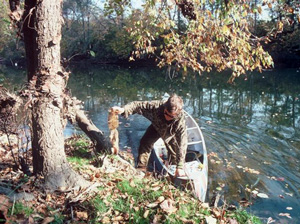
Every type of squirrel hunting has its own unique appeal. The stand hunter enjoys scouting for sign, such as chewed corn husks and hickory nut fragments, then setting up in the perfect spot and waiting for the quarry to begin its morning or afternoon feeding. The still hunter likes a more active approach, moving slowly through hardwoods like he was on a miniature big game hunt, searching with eyes and ears for the telltale sign of his quarry. Dog hunters, like all hound hunters, enjoy experiencing the skills of their canine companions as much as they do bagging the game they pinpoint for them.
While I've enjoy all of these types of squirrel hunting over the years, my favorite tactic is a totally different one: float hunting. This is one of the most effective tactics I know for bagging a few bushytails for a delicious Brunswick stew, and also one of the most enjoyable.
Why Float Hunting?
 The reasons float hunting is so productive is that squirrels are easy to see. They don't expect danger from the water. You move silently along with the flow, so other than a sculling paddle or stroking oar, there's no movement to betray your location to the quarry. And rivers in most cases flow past mature hardwoods that provide perfect bushytail habitat. Often farms along the edge offer crops such as corn to supplement the abundant nuts from the hickories and oaks lining the banks.
The reasons float hunting is so productive is that squirrels are easy to see. They don't expect danger from the water. You move silently along with the flow, so other than a sculling paddle or stroking oar, there's no movement to betray your location to the quarry. And rivers in most cases flow past mature hardwoods that provide perfect bushytail habitat. Often farms along the edge offer crops such as corn to supplement the abundant nuts from the hickories and oaks lining the banks.
Rivers also flow through mostly roadless areas. Since few hunters are willing to hike in to these remote spots just for a squirrel, you're hunting largely virgin territory, making the quarry less wary than in heavily-hunted areas.
Choose the Right River, Follow Regulations
Check with wildlife biologists and game wardens to locate good rivers for float hunting near your home that flow through hardwood forests or mixed hardwoods and farmlands. Then check the state regulations. In many cases, you need to obtain permission from the landowner or select a stretch that flows through public land where hunting is allowed.
Then check on the access situation. You need to find a location where you can launch at one spot and leave a second take-out vehicle at another access point 4-8 miles downstream. Avoid rivers with dangerous rapids. Also stay away from those with dams that can slow the river's flow and require portaging around. Often you'll know of good rivers to try from fishing float trips you've made during summer.
Simple Equipment Needed
A Jonboat, canoe or inflatable boats will work. Canoes are easier to paddle through unproductive stretches, but on the best rivers you won't have to do much paddling. However, Jonboats and rafts are more stable for this hunting technique. If the boat is shiny or brightly colored, spray paint it with a dull tan, gray or drab green finish or even a splotchy camouflage pattern. Sometimes I even tie a bit of brush to the bow of the boat. That's especially helpful if you hope to bag a few ducks as well as squirrels.
Be sure you bring life vest and a spare paddle. Oars can be used, but I like a simple, short sculling paddle so I create minimal movement and disturbance that could spook the game. I also like to carry an anchor. Sometimes you'll see a squirrel that will scurry around a tree trunk out of sight before you can get a shot off. If you can anchor out; however, it will usually come back out in a few minutes.
Another piece of equipment to carry is a landing net. The majority of squirrels float if they fall in the water after the shot. A few will sink, though. If you get to them quickly and have a landing net, you can easily scoop them up.
Other gear to bring:
- survival kit
- dry bag with change of warm clothes
- topographic map
- GPS unit
- binoculars
Rifle or Shotgun?
While rimfire rifle hunting squirrels is fun on land where legal, for float hunting, shotguns are the top choice. Sometimes there are homes close to a river's edge so short-range firearms are best. I like an improved cylinder choke, or improved and modified for a double barrel. Size 6 shot in high brass loads works well, but #4 or #5 pellets are also good. Choose any gauge from 12-20. (And while we're on the subject of guns, make sure your firearm is always pointed away from the other hunter in the boat with the safety on.)
Hunting Tactics
 |
| Hunting from water gives you a better view of squirrels in their habit. |
Try to be at the launch point right at first daylight. For one thing, squirrels get up early and you need to be out there when they are active. But there's another strategic advantage to this. You'll be first on the water and get first crack at the quarry, in case others plan to hunt that stretch.
Even if another boat does get in ahead of you, though, don't worry. Simply let them float half a mile or so downstream and then launch. There will be plenty of squirrels left after they float through and they'll be coming back out again by the time you make the drift.
Early in the mornings look for squirrels low in the trees and also on ground along the river's edge. They're actively feeding now and getting a drink from the river. From mid-morning to mid-afternoon, the higher treetops should get the most attention. During the last couple hours of light, concentrate again on searching on the ground and in the lower branches.
As winter sets in, squirrels may sleep a bit later and wait for it to warm up before venturing out. At this time of year mid-morning to mid-afternoon is often the best time to be on the water.
You may be lucky and spot your quarry scurrying up a tree trunk or jumping from branch to branch. Those are the easy ones. Wait for them to pause and then fire, aiming towards the front shoulder and head. If they're moving slowly but might get out of sight, you can try swinging on them and making the shot.
Other times you may have to search harder to find the quarry. Often you'll simply see an odd hump on a branch or tree trunk. Look carefully and it may be a squirrel.
Also listen for the sounds that can reveal a bushytail's presence. The pitter-patter of nut fragment falling, sharp teeth gnawing through a hickory shell, rustling leaves, or the various scolding and barking sounds squirrels make can all alert you to a squirrel's location.
Shoot a few squirrels. Then pick up a fly or spinning rod and catch a few bass, trout or panfish throughout the remainder of the float. Or simply sit back and watch the sights along shore and listen to the clear gurgling water as it rushes over limestone ledges. It's hard to think of a better way to spend an autumn or winter day.
- 9162 views

